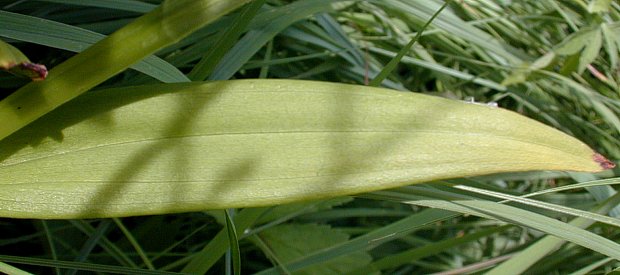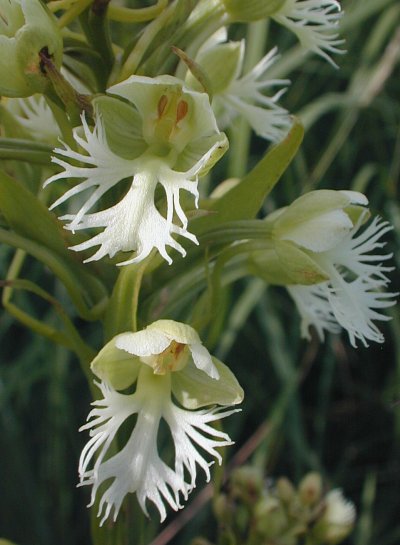Description: This perennial plant is about 1-2' tall, forming a single central stem with occasional short side stems. The alternate light green leaves are up to 6" long and 1½" across, and become smaller in size as they ascend the stem. They are lanceolate or narrowly lanceolate, and sparsely distributed overall. The lowest leaves clasp the stem, while the middle and upper leaves are sessile or have short petioles. They have smooth edges and texture, with faint parallel veins.

The central stem terminates in a raceme of flowers, often with a half-dozen or more blooming at the same time. One or two smaller sides stem may each produce racemes of flowers as well. Each flower is about 1½" long and 1" across, consisting of 3 greenish white sepals and 3 white petals. The upper sepal and two upper petals form a hood over the pollen- and nectar-bearing organs of the flower. The lateral sepals are similar in shape, but spread outward. The large white lower petal, or lip, is divided into 3 parts and heavily fringed. There is a long nectar spur that arches downward from the back of the flower. During the day, the flowers have a slight fragrance, which probably becomes stronger at night. The blooming period occurs during early to mid-summer, and lasts about a month. There is a dense cluster of roots that are fleshy and tuberous. They form a symbiotic relationship with endomycorrhizal bacteria, and rarely form offshoots. The tiny seeds are easily carried aloft by the wind, and can travel a considerable distance.

Cultivation:
The
preference is full sun to light shade, and moist conditions. The soil
should be high in organic matter, preferably with a little sand, and
the pH should be mildly acid to neutral. However, this orchid is more
robust than most and will tolerate conditions that deviate somewhat
from the above. Germinating the tiny seeds normally requires the
presence of an appropriate fungus, which they invade. Artificial
techniques have been developed to speed up the propagation of orchids.
Large transplanted plants from a specialist nursery are the easiest to
handle and have the best survival rate, but they are expensive, if
available at all.
Range & Habitat:
The Prairie White-Fringed Orchid occurs in scattered counties of
central and northern Illinois (see Distribution
Map), where it is native. Only small, local populations of
this rare plant exist
in high quality habitats. It is listed as 'endangered' by the state of
Illinois, and is considered 'threatened' by the U.S. government.
Habitats include moist to mesic black soil prairies, sand prairies,
thickets, pot hole marshes, and fens. At one time, this orchid was far
more common, and hundreds of plants could be observed blooming in
prairie habitat, particularly near the Chicago region. Habitat
destruction and over-collection brought this joyful abundance to an end.

Faunal
Associations:
Various species of Hawkmoths pollinate the flowers. While seeking the
copious nectar, a moth may acquire some pollen on its head, which is
then carried to another plant in bloom. One observed floral visitor of this
orchid is Xylophanes tersa (Tersa Sphinx). A weevil, Stethobaris ovata,
feeds on this orchid; the larvae feed within the seedpods, while the
adults feed on the foliage, buds, & flowers (Dunford, & Young,
& Krauth, 2006).
Mammalian herbivores will readily consume this plant if they encounter
it, including rabbits, deer, and livestock. It may be necessary to
protect this plant with a wire cage where such animals are present.
Photographic Location:
A prairie in east-central Illinois.
Comments:
This is one of the most beautiful wildflowers in a prairie. Rejoice
should you discover one or two plants in bloom. There is a slightly
larger orchid, Platanthera praeclara, with a
similar appearance, that occurs in prairies west of the Mississippi
River.